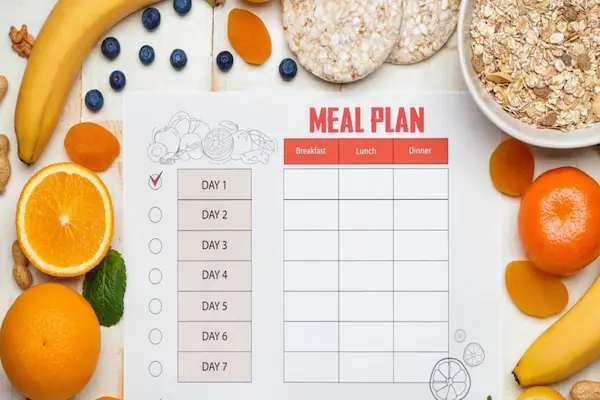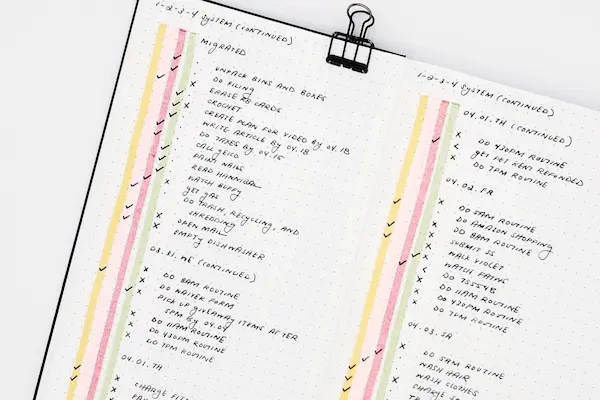Meal planning doesn’t have to be complicated or time-consuming.
The key to planning meals simply is to focus on a few easy steps: choose simple recipes, make a clear grocery list, and set a routine for planning and shopping.
This approach saves time, reduces stress, and helps avoid food waste.
By starting with just weeknight dinners or choosing meals that use similar ingredients, anyone can create a manageable plan that fits their schedule.
Preparing enough for leftovers or making quick lunches keeps the process even easier.
With a clear plan, grocery shopping is more efficient, making healthy eating more accessible.
Understanding Simple Meal Planning
Simple meal planning saves time, cuts grocery costs, and limits food waste.
It involves making clear choices about meals, avoiding common errors, and knowing how it differs from meal prepping for better kitchen management.
Benefits of Meal Planning
Meal planning helps people shop smarter by using a list based on real meal ideas.
This reduces impulse buys and food thrown out because of spoilage.
It also makes cooking faster because meals are decided ahead, so fewer last-minute decisions are needed.
Eating becomes healthier when meals are planned, as balanced options can be included deliberately.
Planning allows portion control and helps avoid fast food or unhealthy snacks.
It can also lower stress by removing daily guesswork on what to eat.
Common Meal Planning Mistakes
One mistake is planning too many new recipes at once.
New meals often take longer to prepare and may lead to frustration.
Sticking to familiar recipes saves time and effort.
Another error is ignoring what is already in the kitchen.
Not using up existing food causes waste and extra spending.
Missing to check grocery ads or coupons can lead to missed savings.
Finally, lack of flexibility can hurt the plan.
Life is unpredictable, so building room for changes keeps meal planning realistic.
Meal Planning Versus Meal Prepping
Meal planning is choosing what to eat for a set time, usually a week, by listing meals and ingredients.
It focuses on organizing shopping and meals ahead.
Meal prepping means cooking or preparing some food in advance, like chopping vegetables or cooking full meals to store.
Prepping reduces daily cooking time but requires extra time upfront.
Planning decides what to cook, while prepping makes cooking faster when busy.
They are different steps toward easier meals.
Setting Clear Meal Goals
Planning meals starts with knowing exactly what to aim for.
This involves understanding food choices and budget limits.
Clear goals help keep the plan realistic and manageable.
Identifying Dietary Preferences
The first step is to recognize what types of foods suit individual tastes and health needs.
This includes allergies, intolerances, or any medical conditions that require special diets.
People should consider if they prefer plant-based meals, low carb, or high protein diets.
It also helps to note favorite ingredients and meals to keep cooking enjoyable.
When meal goals match dietary preferences, it becomes easier to stick with the plan consistently.
Writing down these preferences prevents confusion and supports better food choices.
It also guides the selection of recipes and ingredients, making shopping and cooking smoother.
Defining Budget Constraints
Setting a clear budget is crucial to avoid overspending.
The goal should include how much money can be spent weekly or monthly on groceries.
This helps in choosing affordable recipes and managing portion sizes.
People can track current food spending for a week to set a realistic budget.
Meal plans can then focus on cost-effective ingredients like seasonal produce, bulk grains, and on-sale items.
Using a budget ensures meals are planned with cost in mind without sacrificing nutrition.
It also reduces waste by buying what is truly needed.
Keeping a simple grocery list tied to the budget is a helpful tool in this process.
Time Management for Meal Planning
Effective meal planning relies on setting the right schedule and dedicating specific time for preparation.
Balancing these two factors helps reduce daily stress and saves time during busy weeks.
Choosing the Right Planning Frequency
Deciding how often to plan meals depends on one’s lifestyle and schedule.
Planning once a week is common, as it fits most people’s grocery shopping habits and allows some flexibility in meals.
Some prefer to plan for a full month to minimize shopping trips and focus on bulk cooking.
This works well for those with steady routines and enough storage space.
For others, a few days at a time may be better, especially if work or family schedules change often.
The key is picking a frequency that matches personal demands, making meal planning feel manageable rather than overwhelming.
Allocating Preparation Time
Effective meal prep requires setting aside regular blocks of time to cook or prepare ingredients.
Many find that dedicating 1-2 hours on a weekend day to chop vegetables, cook grains, or batch-cook proteins can save time during the week.
Using a timer or checklist helps keep preparation focused and efficient.
Breaking cooking into small tasks spread over several days also reduces fatigue.
Meal prep that fits into easy, consistent time slots supports sticking to the plan without causing extra stress or last-minute rushes in the kitchen.
Creating a Personalized Meal Planning System
A simple meal planning system fits a person’s daily needs and lifestyle.
It helps organize groceries, saves time, and reduces food waste.
Choosing the right tools and using templates can make meal planning easier and more efficient.
Selecting Planning Tools
Choosing the right tool is key to building a meal plan that works.
Some prefer digital options like apps or online calendars, which help schedule meals and create grocery lists.
Others might choose a simple paper planner or a whiteboard for quick, visible notes.
Tools should match a person’s routine and habits.
For example, an app with reminders suits busy schedules.
A reusable meal planning board works well for those who cook the same meals weekly.
The best tool is the one they will use consistently.
Using Meal Planning Templates
Templates provide structure to planning without starting from scratch every week.
They often include spaces for breakfast, lunch, dinner, and snacks, making it easy to fill in meals quickly.
Using a template helps balance meals, ensuring variety and nutrition.
Some templates also allow space for grocery lists or prep notes.
Printable or digital templates can be customized to fit specific diets or family sizes.
This consistency simplifies shopping and cooking decisions.
Building Balanced Meal Menus
Creating meal menus requires careful thought about what foods to include and in what amounts.
Key factors involve making sure meals supply essential nutrients and have the right balance of proteins, carbs, and fats.
Nutritional Considerations
A balanced meal menu includes a variety of foods to cover important vitamins, minerals, and fiber.
Vegetables and fruits should make up a large part of the menu, providing antioxidants and nutrients that support overall health.
Including whole grains like brown rice or whole wheat bread adds fiber and helps with digestion.
Lean proteins such as chicken, beans, or fish supply amino acids needed for muscle repair and immune function.
It’s important to limit processed foods high in added sugars, unhealthy fats, and salt.
Drinking enough water with meals also supports digestion and nutrient absorption.
Planning meals with these priorities helps keep nutrition well-rounded.
Balancing Macronutrients
Macronutrients are proteins, carbohydrates, and fats, and balancing these is essential for energy and bodily functions.
A good rule is to fill about half the plate with vegetables and fruits, one quarter with protein, and the remaining quarter with carbohydrates.
Protein sources can include beans, eggs, meat, or dairy.
Carbohydrates should come from whole and minimally processed options like oats, quinoa, or sweet potatoes.
Healthy fats like olive oil, nuts, and avocado support brain function and help absorb fat-soluble vitamins.
Portion control matters too; too much of any macronutrient can affect weight and energy levels.
Using a simple plate model can help visualize this balance and make meal planning quicker and more consistent.
Sourcing Ingredients Efficiently
Efficient ingredient sourcing helps keep meal planning simple and cost-effective.
Careful preparation and smart buying choices reduce waste and ensure fresh, quality food.
Knowing exactly what to buy and where helps save time and money.
Making Shopping Lists
Creating a clear shopping list starts with reviewing meals planned for the week.
This keeps purchases focused only on needed items, avoiding impulse buys.
Lists should divide ingredients by type, such as produce, dairy, and pantry items.
This organization speeds up shopping and helps spot items already at home.
Including quantities prevents overbuying and waste.
Checking local seasonal availability also refines the list to what is fresh and affordable.
Apps or printable lists can track needs and previous purchases.
Keeping digital or paper lists updated reduces forgotten items and duplicate purchases.
Shopping Smart for Ingredients
Smart shopping involves choosing local, seasonal produce whenever possible.
These items are typically fresher, less expensive, and support local farmers.
Buying in bulk for staples like grains or legumes can lower prices and reduce frequent store trips.
However, it’s important to store bulk items properly to maintain quality.
Comparing prices between stores and assessing quality prevents overspending.
Building relationships with trusted suppliers or farmers helps access better deals and fresher products.
Prioritizing sustainable and ethically sourced ingredients ensures quality without sacrificing responsibility.
This often aligns with better taste and health benefits.
Simplifying Recipe Selection
Selecting recipes that are both practical and enjoyable helps reduce stress when planning meals.
Focusing on straightforward dishes and familiar favorites can save time and make shopping easier.
This also helps prevent waste and keeps mealtime consistent.
Choosing Easy-to-Prepare Dishes
Choosing recipes that require few ingredients and simple steps is key.
Meals like stir-fries, one-pan dishes, and sheet-pan recipes are good options because they cut down on prep and cleanup.
It helps to avoid new, complicated recipes during busy weeks.
Instead, stick to dishes that take under 30 minutes to cook or use leftovers creatively.
Using basic cooking methods like roasting, boiling, or sautéing makes the process smoother.
Keeping a list of reliable recipes on hand speeds up decision-making.
They can rotate throughout the week so no meal feels repetitive but remains easy to prepare.
Incorporating Family Favorites
Including family favorites builds meal planning around known tastes, which reduces mealtime complaints and food waste.
It also makes cooking faster because those dishes are already familiar.
Families benefit from creating a core meal list of 4-5 go-to recipes everyone likes.
These can be rotated weekly or monthly and tweaked slightly for variety.
Favorite meals can inspire simple variations.
For example, turning chicken tacos into chicken quesadillas or swapping vegetables in a pasta dish keeps things fresh without extra planning time.
This method supports balanced meals since preferences and portion sizes are better understood.
It also helps with grocery lists, focusing purchases on essentials.
Meal Preparation Tips for Busy Schedules
Efficient meal preparation saves time and stress during busy weeks.
It involves planning tasks ahead and cooking in large portions to make meals easy to access and reheat.
This approach helps maintain a healthy diet without spending too many hours in the kitchen.
Preparing in Advance
Preparing meals in advance means setting aside time to handle multiple cooking tasks before the week starts.
It can include washing and chopping vegetables, cooking grains, or portioning snacks.
A key step is making a shopping list based on planned meals.
This reduces last-minute store trips and food waste.
Using airtight containers keeps prepared food fresh longer.
Labeling them with dates helps track what needs to be used first.
Freezing pre-cooked meals can also extend their life.
This technique works well for soups, stews, and casseroles.
Batch Cooking Basics
Batch cooking means making large quantities of a meal at once to eat later in the week.
Hearty meals like pasta, stir-fries, or roasted veggies hold up well over time.
Cooking these in bulk saves daily cooking efforts.
It’s helpful to use recipes that share ingredients.
This cuts down on shopping and prep time.
Portion meals into containers right after cooking.
This makes grab-and-go meals easy and reduces overeating.
Maintaining Variety Without Complexity
Meal planning can include different dishes without making the process hard or time-consuming.
Using simple strategies, anyone can keep meals interesting while sticking to a manageable routine.
Rotating Meal Themes
One easy way to add variety is to set a few meal themes for the week. Themes might include tacos, pasta, salads, or stir-frys.
By sticking to these categories, it becomes easier to swap ingredients or recipes without overthinking. This approach saves time in deciding what to cook each day.
It also helps balance meals by including different food groups regularly. For example, a taco night could feature beans or chicken.
Pasta night might include veggies and lean protein. Creating a rotation of 3 to 5 themes lets a person plan meals ahead.
It avoids repetition but keeps shopping lists simple.
Adding Seasonal Ingredients
Using seasonal produce is another way to keep meals fresh without extra effort. Seasonal fruits and vegetables are often cheaper and taste better when in season.
Switching ingredients based on what’s available means meals stay exciting. For instance, summer squash can replace winter root vegetables in bowls or stir-fries.
This strategy also encourages eating a wider range of nutrients year-round. Planning with seasonal items helps reduce stress and adds natural variety to the diet.
Staying Consistent With Your Meal Plans
Consistency helps make meal planning easier and more effective. It involves dealing with common obstacles and knowing when to change plans to fit real-life needs.
Overcoming Common Challenges
Many people struggle with sticking to meal plans because of cravings, busy schedules, or unexpected events. One way to overcome this is by keeping simple, healthy snacks available.
This reduces the chance of reaching for fast food. Planning meals around a regular grocery shopping routine helps avoid last-minute trips or ordering takeout.
Preparation can also reduce stress during hectic days. Batch cooking or prepping ingredients ahead of time saves both effort and time later.
Tracking progress and setting small, realistic goals can motivate continuous effort. When cravings or social events arise, having a flexible mindset helps maintain control without guilt.
Adjusting Plans as Needed
Meal plans should not be rigid. Life changes, so the plans should change too.
If a plan feels too complicated or time-consuming, simplifying meals can make sticking with it easier. If someone finds they are wasting food, adapting portion sizes or mixing leftovers into new meals helps reduce waste.
It’s also important to listen to personal preferences or energy needs and adjust accordingly. Reviewing the meal plan weekly allows for quick fixes.
This keeps plans realistic and prevents frustration.
Tracking Progress and Making Improvements
Tracking progress helps keep meal planning effective. It shows what works and what needs to change.
Regularly checking success and getting feedback keeps the plan useful and practical.
Measuring Success
Measuring success means looking at clear results from the meal plan. This can include checking if energy levels stay steady or if the person is eating more balanced meals.
Tracking can be done by keeping a food diary or using apps to log what is eaten. Some key ways to measure success are:
- Recording meals: Writing down what was eaten daily helps spot patterns.
- Noting changes: Tracking weight, mood, or digestion can show effects of foods.
- Comparing goals: Check if the plan meets goals like less stress or less wasted food.
Seeing these results shows where the meal plan works well and where it needs changes.
Gathering Feedback
Gathering feedback means getting input about how the meal plan feels in real life.
This can be from the person following the plan or from a dietitian or coach.
Important aspects of feedback include:
- Honest thoughts: Asking about taste, portion sizes, and meal prep time.
- Challenges: Identifying what made following the plan hard.
- Adjustments: Using feedback to change recipes or meal timing.
Regular check-ins and open conversations help make the plan easier to follow.






